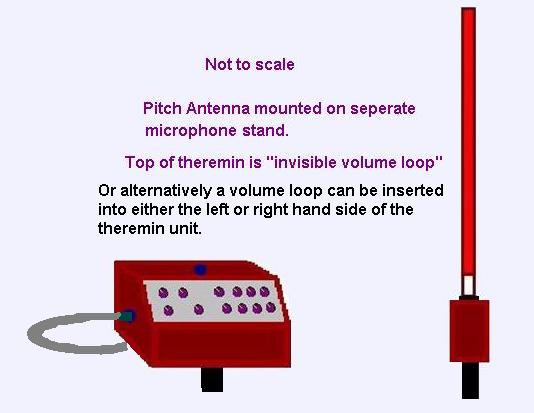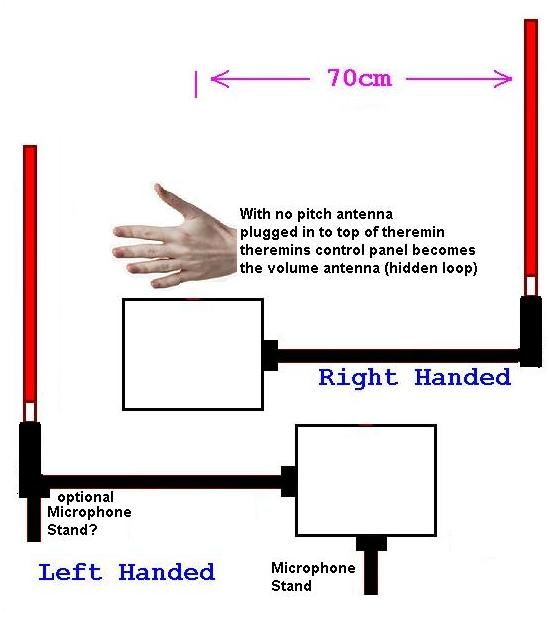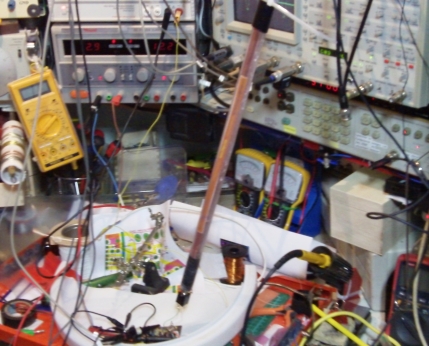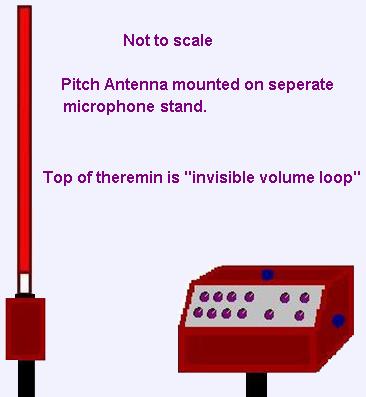"Over the years, I have seen many people attempt to improve upon Leon Theremin's original designs. They reposition and reconfigure the antennas, they reverse the response, they do all sorts of things without realizing that all these "improvements" were experimented with extensively back in the 1930's and, for one reason or another, rejected". - Coalport
I accept this - I am sure that Lev did extensive evaluations and that the way the theremin (and particularly its physical form) came to be was no accident.
I think that these "refinements" Lev introduced are possibly of vital importance for the few truly precision thereminists on the planet, but probably of little or no importance to the vast majority of theremin players - for this majority, I suspect that other constructions could be advantageous.
The technology to implement a seperate relocatable pitch antenna was not directly available to Lev (it would have meant building two seperate instruments - one for pitch and one for volume) and in fact has not really been easily available for modern theremins - although having seperate pitch and volume sections is simpler to achieve with solid state than with valves -
"With regard to the volume, I do feel, as Coalport does, that a loop is a good idea. (If for no better reason than to stop me slapping the top of the unit when i get overly enthusiastic.) Perhaps AIK's idea of a false loop could be adapted to this be putting a plastic ring supported on pillars above the top of the theremin to give the player something to aim at." - Gordon.
Thanks for confirming my fears, Gordon! ;-) -
It seems that the loop must stay - The "false loop could be adapted to this be putting a plastic ring supported on pillars above the top of the theremin" might be a good idea, but it would still be different..
So I will play safe.. the "design" I have shown above could easily have a conventional loop stuck into the socket on either side - extending the loop on an arm would not be needed as the pitch antenna can be moved to an appropriate distance - If the loop is conventional (non-directional) then the same loop can be swapped to left or right hand sides
The only disadvantage in the whole scheme that I can see is the need for a seperate stand for the pitch antenna if this mode is used, but for performers this could be an advantage "from a performance point of view, part of the thrill of playing live is how exposed the performer is to the audience".
So at present, I propose the following options:
1.) Theremin unit with antenna mounted on its top, having volume antenna rod plugged into either side, and option of "dummy loop" on the end of this volume rod.
2.) Seperate relocatable Pitch antenna, Theremin unit with "invisible" volume antenna on its top face.
3.) Seperate relocatable Pitch antenna, Theremin unit with conventional volume loop plugged into either side.
All of these options would be available from a standard build - Thereminists could choose a "real loop" or a "rod loop" as extras - The pitch antenna being operable on top of the theremin if a rod-loop is used, otherwise as a seperate microphone stand mounted antenna used with either the hidden loop, or with a real loop.
Thank you all..
As to when and if this will ever materialize, I cannot say -
I need to (am being forced to) move out of my home in the near future, and unless I can find a way to move with enough space to continue my "business" and get finance to put the stuff into production, my "journey" is over.. At present I cannot even see a way to survive and get accomodation for myself, let alone do any manufacturing.. So its all looking really grim.
I hope to build one prototype in the next few weeks if lifes other major traumas dont prevent this.. then perhaps try to sell this complete with all the designs and data and hope someone will buy the package and put it into production.. I am in the process of doing my final accounts to close my business (or perhaps put it into suspension).. Unless fortunes face looks my way in the very near future.
Fred.








